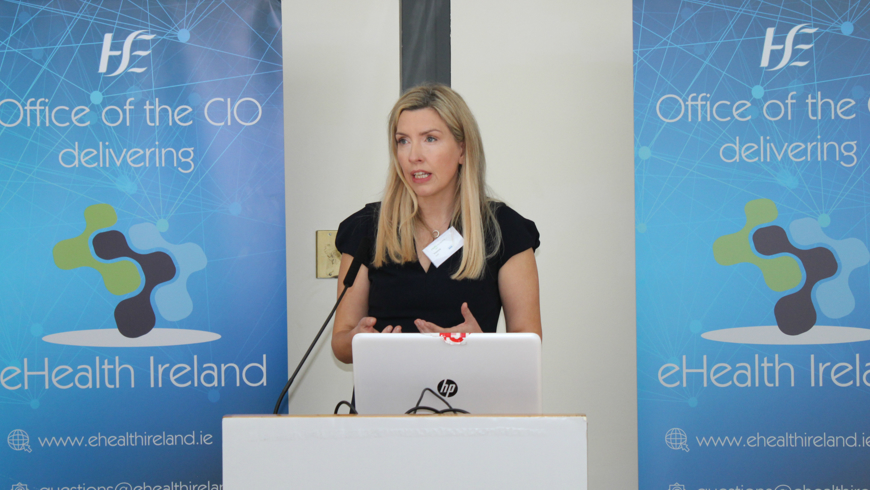
Annual Gathering of the Council of Clinical Information Officers
Clinicians Supporting the eHealth Sláintecare Implementation Programme key focus at CCIO event.
May 2019
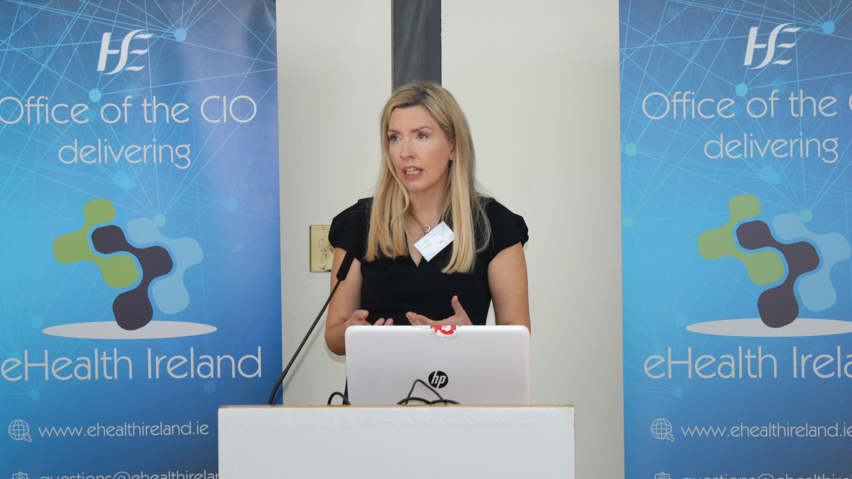
Yvonne Goff HSE’s Chief Clinical Information Officer
Opening the Council of Clinical Information Officers’ annual conference in Dublin on May 29 the HSE’s Chief Clinical Information Officer Yvonne Goff highlighted the theme of the day ‘Clinicians Supporting Sláintecare.’
She gave a broad overview of the priorities of the Office of the Chief Information Officer for 2019 which include cyber security, enabling ICT systems for the children’s hospital, Medlis and NIMIS enhancements.
Yvonne Goff also updated attendees on the Integrated Information Service (IIS) and explained the dual importance of having access to quality information in terms of patient care and planning services. IIS will facilitate this by providing a centralised service that creates and maintains policies, standards and governance around the HSE’s data.
Key speakers
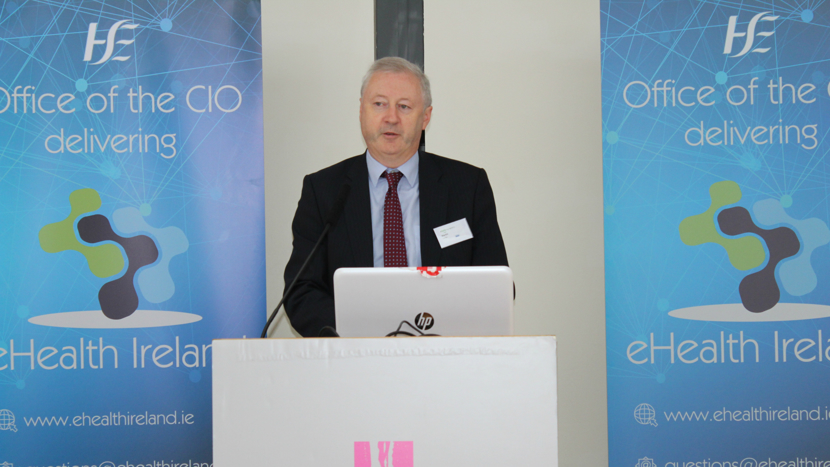
Professor Martin Curley, Director of the HSE’s Digital Academy
Professor Martin Curley, Director of the HSE’s Digital Academy, explained the objective and vision of the digital academy which are to develop and unleash the digital capabilities of the HSE and through this, to drive breakthrough improvements in efficiency, effectiveness and experience.
The core digital strategy which powers the digital academy is ‘Stay left, Shift left’ which aims to keep people well with innovative digital solutions including apps which can keep us healthy and identify when interventions are required. Shift left involves the use of technology to facilitate moving people from an acute setting back into the community.
The key objectives of the digital Academy are to: Accelerate the adoption of digital technologies/solutions with leaders across the organisation to transform Irish Healthcare; Support and influence digitally driven change across the organisation to support the successful implementation of Slaintecare; Build a consistent vocabulary, language and tone across the organisation and deliver a digital learning program.
Muiris O’Connor, Assistant Secretary, Department of Health outlined the importance of Slaintecare describing it as a fantastic opportunity for healthcare reform.
He added: ‘‘One of the most important uses of technology is to see through the vast amounts of data, business and metrics produced in Health to plan the path to improving the health and wellbeing of the citizens of the country. eHealth, Integrated Information Services and the Individual Health Identifier are key components of unlocking all this data and of delivering an integrated healthcare model built around the needs of citizens according to Muiris. The challenge for the HSE is that there are vast amounts of data but this data provides us with little information and even less intelligence.’’
He welcomed the fact that for the first time, eHealth was a component of recent negotiations with GP’s regarding new contracts and highlighted the need to deliver clear outcomes and tangible benefits to the public from digital healthcare.

Muiris O’Connor, Assistant Secretary, Department of Health, Dr Barbara Foley, Health Information with HIQA
Dr Barbara Foley, Health Information with HIQA spoke about ‘Guidance on a data quality framework for health and social care in Ireland’.
She articulated the concept that the quality of the data we gather is as important as the data itself. She displayed how if we are to implement Slaintecare effectively for systems such as ePrescribing and summary care records, we need to have confidence in the quality of the data we are collecting . The complexities for data quality were broken down and the importance of the different components were explained. These components included data being relevant, accurate, timely, coherent and accessible.
Dr Elaine Walsh gave a presentation on the Patient-Held Active Record of Medication Status system. This system is an electronic solution to the problem of medication errors in patients moving between hospitals and the community. Dr Walsh outlined how the rationale behind the design of the system at its core was the realisation that the patient is the only constant in transitional care and that the intervention should centre around them. The solution was to design a minimal viable product using USB technology. What made this USB device unique was the fact that no patient information was stored on the device. The device was shaped like a normal key and acted as a digital key to the patients’ medical records.
Dr Walsh gave a fascinating insight into the process of developing and implementing the solution and into the challenges faced with clinical staff, ICT staff, embedded culture and the patients themselves. The results of the study proved their digital system reduced medication error and was acceptable to the key stakeholders. The presentation encapsulated the essence of the CCIO where a combination of academia, outside vendors, ICT and clinical staff designed, implemented and delivered a digital solution which has the potential to save lives and enhance healthcare.
Panel discussion
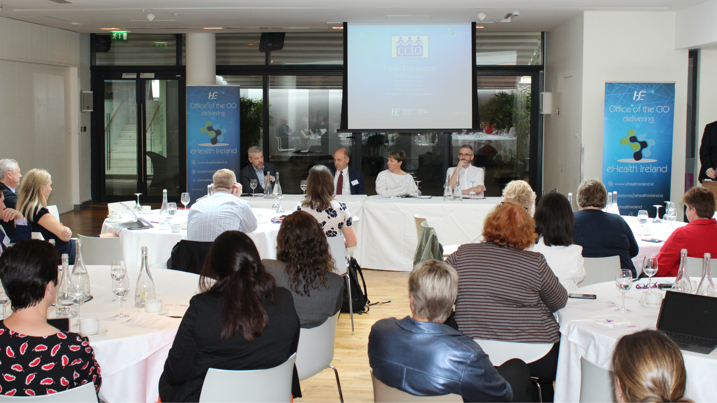
Professor Richard Greene, Clinical Lead Obstetrics, HSE, Loretto Grogan, National Clinical Information Officer – Nursing and Midwifery, HSE, Dr Michael Riordan, Chief Clinical Information Officer, Children’s Hospital Group and Professor Conor Shields, Chief Medical Information Officer, Ireland East Hospital Group.
A panel discussion took place including Professor Richard Greene, Clinical Lead Obstetrics, HSE, Loretto Grogan, National Clinical Information Officer – Nursing and Midwifery, HSE, Dr Michael Riordan, Chief Clinical Information Officer, Children’s Hospital Group and Professor Conor Shields, Chief Medical Information Officer, Ireland East Hospital Group.
Discussions centred on the challenges and opportunities with Slaintecare and there was enthusiastic participation from the audience. A general consensus came out from the discussion that there is an appetite for change in healthcare from patients and healthcare staff and that Slaintecare gives us a unique chance to put patient at the centre of healthcare going forward using data and technology to facilitate this.
Community care and clinical engagement
Mary Cooke, Deputy Delivery Director Community ICT, gave an update on ICT in the community sector. Lily Connolly spoke about Mental Health eRostering and Linda McDermott outlined the Single Assessment Tool.

Mary Cooke, Deputy Delivery Director Community ICT, Lily Connolly and Linda McDermott
Dean Sullivan, HSE Deputy Director General of Strategy, outlined his vision of the HSE Health Strategy. Dean gave an honest appraisal of where the HSE is and the array of challenges we face. He enjoined us to fundamentally change our approach with a view to delivering improved population health and a timely, responsive, high quality health and social care service. He laid out a plan where we can incorporate Slaintecare and eHealth Ireland to effect change and deliver an enhanced Health Service.
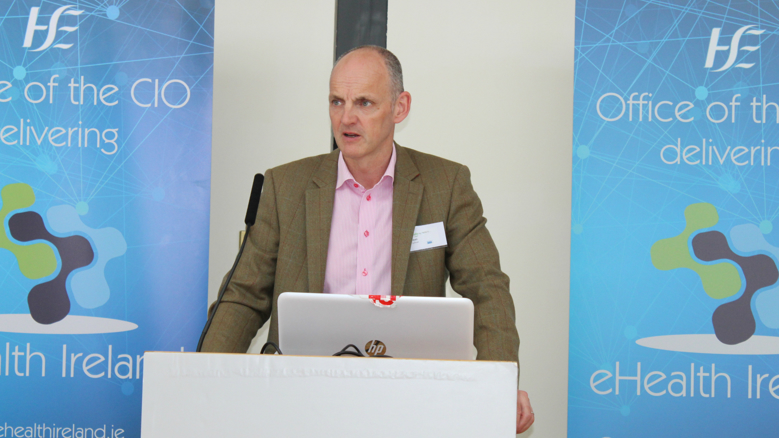
Dean Sullivan, HSE Deputy Director General of Strategy
Vincent Jordan, Delivery Director, Acute ICT spoke about the essential contribution that clinicians bring to delivering better care using digital tools. He explained how this contribution resulted in more effective workflows and safer patient care in the Irish Healthcare System.
To highlight this in practice, Vincent introduced three successful initiatives in the Acute Sector and outlined how these were built on the culmination of IT excellence organisational alignment and clinical leadership. He invited senior clinicians involved in these initiatives to share their experience with the CCIO gathering.

Vincent Jordan, Delivery Director, Acute ICT, Brian Cleary, Chief Pharmacist in the Rotunda
The first initiative discussed was the Maternal and New-born Clinical Management System. Brian Cleary, Chief Pharmacist in the Rotunda, delivered a captivating view of all the stages of delivering the project. He outlined how his team were overwhelmed at the start by the scale of what they intended to achieve yet through strategizing and planning they delivered right through to the whirlwind of go live.
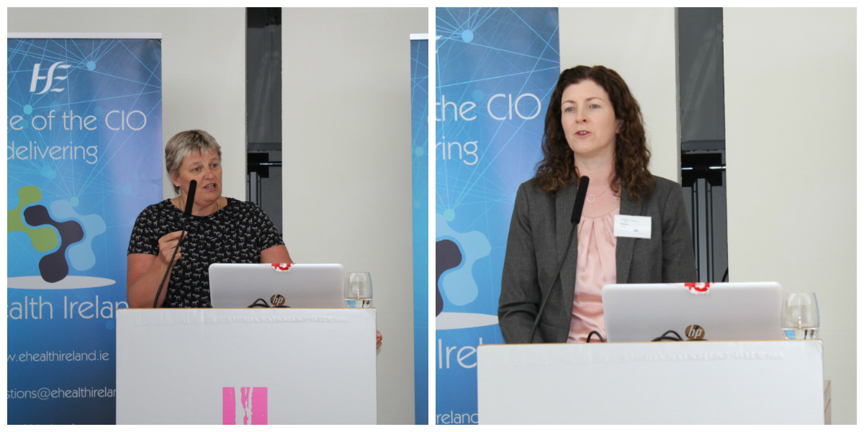
Dr Grainne Courtney and Miriam Roche
The St James’s Hospital Project Oak Electronic Patient Record Implementation was outlined next by Dr Grainne Courtney and Miriam Roche.
The work that went into delivering this initiative was detailed from the years of preparation , the training of over 2,500 users and over 1,100 testing issues they had to work through to the delivery of a hugely successful Electronic Patient Record (EPR) which is already delivering visible efficiencies in how care is delivered. The result of the EPR implementation is all inpatient records are now accessible via an electronic system with details of patients’ medication and prescriptions, allergies, health conditions, treatments and social care information all accessible in one place.
To download the slide decks from the event, choose from the list below:
Barbara Foley HIQA Data Quality Framework.pdf (size 2 MB)
Brian Cleary MN-CMS Elec Med Man.pdf (size 2 MB)
Grainne Courtney Miriam Roche EPR implementation.pdf (size 2 MB)
Chief Clinical Information Officer - Yvonne Goff.pdf (size 905.1 KB)
CCIO Health App Library.pdf (size 335.4 KB)
Elaine Walsh UCC Pharms.pdf (size 1.1 MB)
Lily Connolly HSE Mental Health eRostering.pdf (size 945.6 KB)
Muiris O'Connor DoH Data as Digital Transf.pdf (size 1.4 MB)
